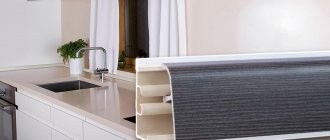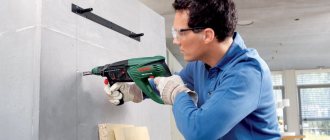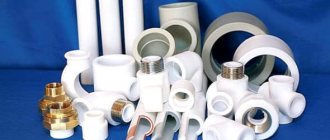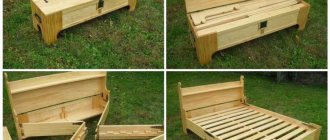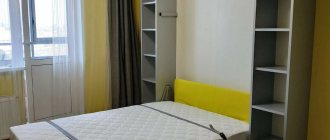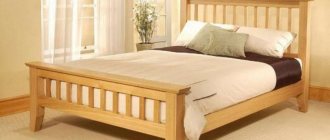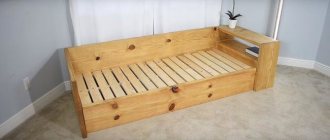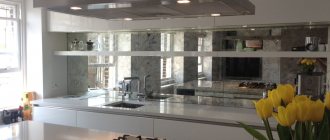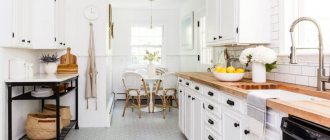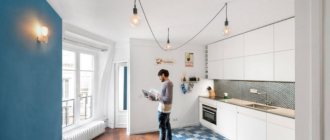Hello, dear friends! Today I’ll talk to you about how to attach the baseboard to the countertop. There are several options. But not all of them are worth using.
Skirting boards are used not only on the floor, but also in the kitchen when assembling a set. It covers the joint between the countertop and the wall. It is also possible to attach it to a tabletop or backsplash.
These elements differ from each other in shape, design, and materials of manufacture. The plastic and aluminum versions are mainly used. Wood, MDF and other materials are rarely used.
Functions of decorative plinth
Since furniture is usually made of MDF or chipboard, the cuts on the reverse side, according to the rules of furniture production, are not protected by any protective edges.
Therefore, as a result of moisture entering from the reverse side, its edges may swell and crack, or it may even begin to rot.
Therefore, the main function of a kitchen plinth is to protect the countertop (if it is made of chipboard) and furniture cabinets from moisture on the end cut, as well as to create an aesthetic appearance for the kitchen unit.
Rules of care
The main function of the baseboard as a barrier is to prevent liquid or solid household waste, which has the ability to decompose under the influence of the kitchen microclimate, from getting into hard-to-reach places. Therefore, if gaps appear between the tabletop and the baseboard, they need to be eliminated. Transparent silicone is suitable for this.
It is important to ensure that no gaps form between the baseboard and the wall. Otherwise, there are no special care rules (except for the obvious - avoid contact with hot objects if the profile is PVC).
Differences in design
The front side of the molding is a decorative profile. During the manufacturing process, a sealant is attached to the back side to fill the gap. Skirting boards are divided by design into two categories - monolithic and universal.
Monolithic products are those that are made from one piece. They have excellent rigidity, so they are not durable in use. And their long-term use is ensured by elasticity.
Moldings are universal and are mounted on a silicone seal. They are more plastic and, accordingly, have a long service life.
Differences in materials
- Wood. Typically, this type of molding is used for countertops made of the same material (chipboard or wood). Varieties of such skirting boards have a low cost, but choosing them in combination with the color of the tabletop is quite difficult.
- Aluminum. Such moldings are quite popular. They have a long service life and are not exposed to heating devices and are easy to clean. They can have different shapes and appearance.
- Plastic. This type is made of PVC. Accordingly, they are easy to change, so they are presented in various modifications.
- Stone. A type of molding from the “good” price category. They are installed using glue and are installed in a vertical position.
- Metal-plastic. This type of plinth can be used for any type of countertops. But installing them next to heating devices is not recommended.
Criterias of choice
The plinth is matched to the countertop, kitchen set or apron . The overall style of the kitchen, the color of furniture handles and household appliances matter.
Here are the main criteria:
- The most successful and win-win option is to choose the color of the countertop. A large assortment of plastic borders allows you to do this without problems.
- On expensive countertops made of artificial stone, marble or granite, borders made of the same material are installed. They are made to order along with the tabletop.
- For modern styles (modern, high-tech, minimalism, etc.) aluminum or steel skirting boards, as well as plastic borders imitating stainless steel, are suitable. They harmonize well with metal handles of kitchen facades and household appliances.
- Skirting boards “under the apron” are made from the material of the apron (porcelain tiles, ceramic tiles, etc.), or special borders “under the insert” are used, into which an edge is inserted that imitates the material of the apron.
- The corrugated front surface is more difficult to care for and dirt accumulates on it. Choose smooth models.
Important! Ready-made skirting boards are cheaper. Consider retail models first.
Types of fasteners for baseboards
Kitchen moldings are divided into removable and non-removable. In the first option, the mounting rail can be dismantled when rearranging the headset, and in the second option it is firmly attached.
Removable ones are attached directly to the tabletop itself, and non-removable ones are attached to the wall. It is not recommended to fasten the plinth to the wall and to the tabletop, because in this case they will be deformed.
In addition, they can be collapsible or non-dismountable. However, they can be attached either with self-tapping screws or with glue. In the first option, the seal is fixed, and in the second, the monolithic rail is fixed.
Conclusion
Worktop skirting is a simple and attractive way to finish off any kitchen, giving it a complete finish, both visually and practically. Despite the fact that we have examined only a small part of these practical decorative products, because there is still a huge variety of moldings and other decorative elements, we have revealed the very essence of the issue (also find out about the features of polyvinyl chloride skirting boards).
Installation (step by step instructions)
You should not try to install moldings made of artificial or natural stone yourself. It's better to invite specialists. But the instructions for installing skirting boards made of plastic, metal, wood and composites will be given below.
Required Tools
In order to cut the baseboard to the required size, you will need a hacksaw for wood or metal. A hacksaw is used when installing solid wood moldings. Soft PVC products are best cut with a carpenter's knife. You also need to prepare a tape measure, silicone sealant, screwdriver or screwdriver.
Screw mounting
Using a tape measure, you need to measure the distance of the tabletop plane on which the molding will be installed and cut it to size. Then, using a screwdriver, you need to drill holes for the screws, first attaching the plinth to the site of the intended installation.
The distance between the holes should be between 15 and 30 centimeters.
- Products made of fragile materials must be drilled with extreme caution, as they may crack. It's best to use glue.
- Before fixing the baseboard to the tabletop, the joint can be treated with silicone sealant to prevent moisture from entering.
- But do not forget that when rearranging it will need to be removed from the surface.
The outer part is secured with latches to the base installed around the perimeter. If the kitchen is corner, then a corner element is fixed at the junction. The outer part extends into the corner by 0.5 centimeters.
It is recommended to apply silicone glue to the joints. Plugs are placed on the edges of the molding, which are included in the kit upon purchase.
Adhesive connection
Before starting the procedure for gluing the molding, it is necessary to remove any dirt and dust from the walls and from the surface of the countertop. If there are grease stains, it is better to remove them with an alcohol solution.
It is also necessary to clean the base surface of the baseboard.
- Before installation begins, the outer surface of the baseboard must be removed and the base cut to fit the size of the countertop surface.
- Then coat the base with glue and press it to the place of intended installation, and then hold it there for the time specified in the instructions for the glue itself.
- If the kitchen is corner, then installation is done from the corner. At the end of the installation, it is necessary to install caps on the edges of the molding.
Methods
Installation Features
Before starting installation work, it is necessary to calculate in advance the length of the strip used to close the gap along its entire length. Many users, based on their own experience, recommend purchasing this consumable with some reserve.
As for fastening the plinth, in addition to the method of installing it on the guide we discussed, the following options are possible:
- use of nails or screws;
- “hard” installation with glue.
Aluminum kitchen plinth
Self-tapping screws for fastening are used only in those rare cases when the installed products are made of materials other than plastic. This is explained by the fact that when using them you can easily damage the mounted plastic workpiece. Well, a “rigidly” glued plinth makes it difficult to replace it if it is necessary to update the decorative strip.
In the case where regular reinstallation is expected (to clean it from dirt or replace it, for example), then it is best for you to use the previously mentioned design with a central guide and a decorative strip.
